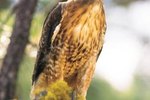Why Cats Hunt Birds
Cats are known as opportunistic hunters. They will eat a number of critters, including birds, mice, rats and other small vertebrates. In general, cats have an easier time catching rodents than they do with birds. Cats in suburbs or even many cities don't get much of a chance to hunt rodents, however. There is little for small rodents to eat outside, and people keep them out of their houses as much as possible. As a result, domestic cats go for birds, even though they are harder to catch.
Hunting Adaptations
Cats have very specialized adaptations that make them good hunters. They have extremely acute hearing, a keen sense of smell and good night vision. They also have very powerful rear legs, and are capable of quick pounces and high jumps. They have sharp claws on forepaws that are strong enough to stun prey. They can climb short distances very quickly, allowing them to attack birds in feeders or trees. Finally, they have powerful jaws with sharp teeth that are capable of delivering a quick, killing blow.
Hunting Basics
To kill an animal, a cat needs to give it a quick bite in the neck. This bite will snap the spine, crush the trachea or sever the carotid artery, killing the animal quickly. Before it gives the killer blow, a cat will attempt to stun the animal. Usually, it will bat it sharply with its paws until the animal isn't likely to strike back. With a small bird, this may take a single swipe. With a larger bird, however, this can take quite a bit of stalking and attacking to wear down the prey.
The Hunting Process
The cat will begin by stalking its prey. It will lower itself close to the ground and watch the bird. Usually, the cat will advance on the bird with short, quick movements, followed by pauses. If the bird sees the cat, it will fly away. If the cat is quick and a bit lucky, however, the bird will not notice it coming closer. When the cat is within range, it will leap at the bird, aiming a swipe of its paw as it pounces. Birds are pretty fast in the air, but they can't always take off quickly enough to avoid a cat. If the cat manages to injure the bird, it is all over. The cat will sometimes play with it, swiping at it and stalking it before making the final kill. A larger bird like a duck may be able to hold off a cat for a while, but a determined feline will eventually wear it down and kill it. Cats are intelligent animals, and will sometimes stake out an area where birds are abundant. Cats sometimes crouch beneath bird feeders, for example, waiting for prey to arrive.
Writer Bio
Isaiah David is a freelance writer and musician living in Portland, Ore. He has over five years experience as a professional writer and has been published on various online outlets. He holds a degree in creative writing from the University of Michigan.





